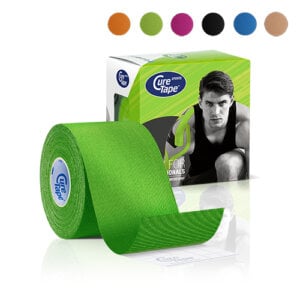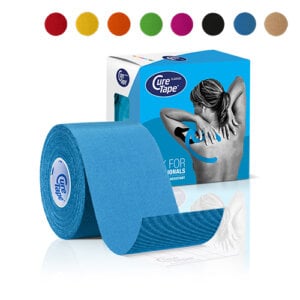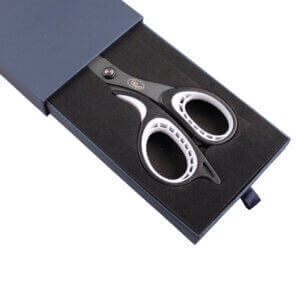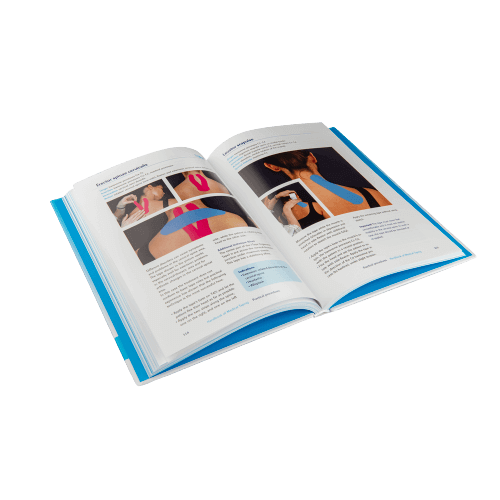Applying CureTape kinesiology tape can reduce the pain and to promote a faster recovery during tennis elbow treatment.
With the term tennis elbow (a type of elbow tendonitis) you could expect that this injury is only caused by playing tennis, but this is actually only the case for 5% of the affected people. Approximately half of the tennis players will eventually be faced with a tennis elbow. Usually a tennis arm occurs on the side (or arm) with which you write. The development of the complaints is mainly caused by repetitive movements. This could be, for example, activities like painting, assembly line work, mouse use and the tightening of screws. This creates an overload and inflammation in the area of the tendon attachment to the elbow bone. 2% of the population experiences a tennis elbow, with an average age between 40 and 50 years. The complaints can also arise from the neck or shoulder region, which a therapist can examine and treat.
Tennis elbow symptoms
- Pain symptoms at the outer bony protrusion of the elbow.
- Painful, tiring, stiff feeling in the arm, especially in the morning.
- Radiation of the pain can occur to the upper arm, shoulder, forearm, wrist and sometimes even to the fingers.
- The pain complaints occur when the stretching muscles of the wrist and hand are tightened.
In addition to the above symptoms, there are also certain exercises where you can determine whether it is a tennis elbow:
- Pain complaints if the hand is stretched while someone else gives counter pressure.
- Pain occurs when a chair with a stretched elbow is picked up at the backrest of the chair.
- Pain when bending the wrist backwards.
Get started with these items to tape tennis elbow
-
CureTape® Sports Kinesiology Tape
 $12.95
In stockSelect options This product has multiple variants. The options may be chosen on the product page
$12.95
In stockSelect options This product has multiple variants. The options may be chosen on the product page -
CureTape® Classic 2″ kinesiology tape
 $12.95
Out of stockSelect options This product has multiple variants. The options may be chosen on the product page
$12.95
Out of stockSelect options This product has multiple variants. The options may be chosen on the product page -
CureTape® Art kinesiology tape 2″
 $13.95
In stockSelect options This product has multiple variants. The options may be chosen on the product page
$13.95
In stockSelect options This product has multiple variants. The options may be chosen on the product page -
CureTape® High Quality Scissor
 $20.00
In stockAdd to cart
$20.00
In stockAdd to cart

Christina’s advice when taping your arm
When taping your arm, it’s crucial to choose a tape that provides strong adhesion and support. That’s why I recommend CureTape kinesiology tape. For regular use, CureTape Classic or Art is ideal. However, if you’re engaging in extreme sports or swimming, opt for the extra sticky CureTape Sports variant!
How to tape tennis elbow video
Tips for Effective Arm Taping:
- Make sure you understand what’s causing the pain or discomfort
- Check if there are any reasons why taping might not be a good idea.
- Before you start, read the instructions carefully.
- Choose a tape colour or print that suits your style!
- Round of all the edges to prevent peeling.
- Avoid stretching the tape at the beginning and end.
- Rub the tape firmly for better adhesion; warmth helps activate the adhesive.
- You can shower or swim with the tape on; just pat it dry gently afterward, avoiding vigorous rubbing.
- To remove the tape easily, use body or massage oil.
How to tape tennis elbow
In addition to a therapeutic treatment such as massage and exercise therapy, CureTape kinesiology tape can be used to reduce the pain and to promote a faster recovery.
Tip: Because the kinesiology tape is placed near the wrist, it could come off easier due to sweat or movements of the hand. By using CureTape Sports (as in the accompanying example), the tape application often remains on for a longer period of time (4-7 days).
Applying the tape
Step 1:

Step 2:

Professional instructions
In order to relieve the extensors / flexors, a blue I-tape is used in this example (extensor carpi radialis longus, extensor carpi radialis brevis and m. Brachioradialis).
- Measure the I-tape in stretched position.
- Lay the base distal to the wrist in a slightly stretched position (hand in neutral position).
- Extend the elbow and bring the hand into palmar flexion.
- Then apply the detonizing tape with slight along the forearm, direction proximal to the elbow over the extensors and rub it firmly; apply the last 5 cm of the tape without stretching. The starting point of the tape is called the punctum fixum and the end point is the punctum mobile.
Use the black tape for activating the m. Supinator. The m. Supinator takes care of turning the hand outwards.
- Apply the base of the I tape with slightly inward twisted position of the elbow (in slight flexion).
- The starting point of the tape (punctum fixum) is on the lateral epicondyle on the origin of the m. Supinator and not on the olecranon (back of the elbow), this can irritate.
Apply the kinesiology tape to the proximal part of the radius. The fascial structures “derotate” in this way. Check the operation of the tape after the application, for example by provoking an active exorotation against resistance. If the pain is reduced, the tape has has been applied well and has started it´s positive influence on the recovery of the tennis elbow.
Instructions for self taping (non-professionals)
To ease tension in the muscles responsible for extending and flexing the wrist, we’ll use a blue I-tape in this example.
- Stretch out the I-tape before measuring.
- Place the base of the tape just below the wrist, keeping it slightly stretched (hand in a neutral position).
- Straighten the elbow and bend the hand downward.
- Then, gently apply the tape along the forearm, moving towards the elbow over the muscles. Firmly rub the tape; leave the last 5 cm without stretching. The starting point is called the punctum fixum and the end point is the punctum mobile.
Use the black tape for activating another muscle that helps in turning the hand outwards.
- Apply the base of the I tape with a slightly inward twisted position of the elbow (in slight flexion).
- The starting point of the tape (punctum fixum) is on the outer part of the elbow, avoiding the back of the elbow to prevent irritation.
Apply the kinesiology tape to the upper part of the forearm. This technique helps the fascial structures to unwind. Check if the tape is working properly after application by testing the movement of the arm. If the pain decreases, it means the tape has been applied correctly and is positively influencing the recovery process.
Learn how to tape
- The Ultimate Taping Guide: Focuses on self-taping for the 30 most common injuries where taping provides support.
- Kinesiology Taping Method Manual: Designed for (para medical) professionals, covering basic taping techniques and various pathologies.
- Decompressive Taping Techniques Manual: Specifically focuses on lymphatic taping methods for decompression.
What are you waiting for? Order a copy today!
THYSOL is the manufacturer of the kinesiology tape brand CureTape. As CureTape, we have been training and supplying professionals for 25 years. And consumers now know how to find us too! By manufacturing all our tapes in our own factory, we can guarantee the best quality!
Please note that the indicated tape applications and information on our website about the possibilities with kinesiology tape have not yet been scientifically proven. The statements and examples mentioned are based on long-term experiences of patients and trained therapists.
Contraindications not to tape: pregnancy, open wounds, broken bones, unexplained complaints, allergies and skin diseases, use of medication such as blood thinners, thrombosis and fever. Always apply tape in consultation with a specialist.


